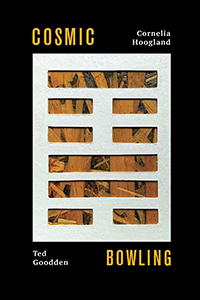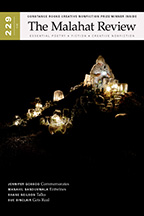Reviews
Poetry Review by Yvonne Blomer
Cornelia Hoogland and Ted Goodden, Cosmic Bowling (Toronto: Guernica Editions, 2020). Paperbound, 156 pp., $20.
 Cosmic Bowling, a collection of numbered poems and photos of small figurative sculptures, based on the I Ching, is a delightful, illuminating book of moments, wonder, and wisdom. The I Ching (sixty-four hexagrams and an accompanying text to help interpret the numbered tiles) is the through line, the source material that both poet and artist turned to, and the interplay between the three elements of this collection (poems, sculptures, I Ching) is fluid. From the numbered hexagrams, Ted Goodden created sixty-four small sculptures, all holding a ball. The ball sets up a relationship, too, between the figure and the hexagram, creating tension and movement. From the I Ching and the small sculptures, poet Cornelia Hoogland created sixty-four six-line poems, six lines to represent the hexagrams: poems that are both personal and collective in how they speak to human experience, to the specifics of her experiences which serve to guide the reader into contemplation. In a way, these are poems with a kind of direct purpose, poems of metaphor and insight.
Cosmic Bowling, a collection of numbered poems and photos of small figurative sculptures, based on the I Ching, is a delightful, illuminating book of moments, wonder, and wisdom. The I Ching (sixty-four hexagrams and an accompanying text to help interpret the numbered tiles) is the through line, the source material that both poet and artist turned to, and the interplay between the three elements of this collection (poems, sculptures, I Ching) is fluid. From the numbered hexagrams, Ted Goodden created sixty-four small sculptures, all holding a ball. The ball sets up a relationship, too, between the figure and the hexagram, creating tension and movement. From the I Ching and the small sculptures, poet Cornelia Hoogland created sixty-four six-line poems, six lines to represent the hexagrams: poems that are both personal and collective in how they speak to human experience, to the specifics of her experiences which serve to guide the reader into contemplation. In a way, these are poems with a kind of direct purpose, poems of metaphor and insight.
In “The I Ching: It Works If You Work It,” the afterword to this ekphrastic, collaborative collection, artist Ted Goodden writes of his relationship with the I Ching: “Sometimes the hexagram speaks directly to the question I’ve posed and sometimes it speaks indirectly, reframing the question or bringing attention to blind spots in my outlook.” He adds that the aha is immediate in the first case, while in the
second, there is a delay; more reflection is required.
This was my own reaction, as I read the poems that respond to each numbered hexagram and studied the accompanying figurative sculptures. The poems work in a similar way. Sometimes the poem seems to leap directly from the sculpture and the sculpture from the hexagram. Sometimes I have to contemplate and wonder. This wondering and opening in a reader are what poetry and art offer. If art, written or visual, has a job, it is to enter its viewer and create openings or cracks, for contemplation. Here is “6. Sung, Conflict”:
Awake at three a.m. in racking rain, drumming
run-off. Boggy demons muddy me; riddles of early hurt
and private mire. But I’m finished cringing.
My emotions are weathers, storms passing through:
saved in the flood or drowning? It’s the sorting
that’s soul work. At three a.m., in the dark, in the rain.
Goodden’s accompanying sculpture has the figure standing, one leg slightly ahead of the other, arms hugging the ball, head lifted. The figure wrestles with the ball in the same way the poet, Hoogland, wrestles with the internal “boggy demons” and with the self, that “sorting soul work.”
With other poems the reader may have to contemplate the image, poem, and I Ching longer to reach that aha moment, as in “50. Ting, The Cauldron”: “Here’s the situation: an artist creates a significant work, furthers / her culture. But even six-line poems must find their audience. / On stage, the artist overcomes nervousness by serving the work. // She enters each phrase, the rocky shore-line they pebble. The / sandstone shelf. Always the possibility of a surge channel, a crevasse / gorged with crashing waves funnelling energetically upward.” The figure is on its knees, holding the ball aloft, an offering. For me, this poem requires more thought and study: it is dense, and contains a volta from the artist and her work into the rocky-shore and its extended metaphor. The cauldron puzzles but then clarifies notions of success in the struggle. The conversational tone invites the reader in.
The poems leap from the I Ching much as the written text interprets the hexagrams for a person throwing the coins and seeking guidance, as in “36. Ming I, Darkening of the Light”: “Let’s say there are ten pictures. In nine of them / I’m what everybody thinks I am, dutiful. But in the tenth, / I’m as I know myself to be. Even when I was a kid // there was a room at my centre—it had windows / that opened to the stars. Time and space / whirled outward, except it was me expanding.” The accompanying sculpture is sitting, ball in lap, hugging or holding.
Hoogland’s poems contain both personal details and, within them, broader insights, not unlike the I Ching. The poem contains an “I” and the “I” contains within it something larger. Her poem leaps and links to the I Ching where “the light has sunk into the earth: The image of Darkening of the Light. Thus does the superior man live with the great mass: He veils his light, yet still shines” (iching-online.com). This
“room at the centre” holds the light.
Throughout the sixty-four pieces, the poems are brief, tight, exact, and specific (an occasional muddled line or line break, when I go back, seems to have purpose). Sometimes they are like haiku, an image standing as a metaphor; sometimes like a sonnet in their complexity and conversational essay-like content. Hoogland said, in a brief interview, “I don’t see the poems as expressing what I have to say in the world, or not about me, anyway, who I am”; rather, they are “not so much mine as me trying to listen to a larger sense of the world. If there is wisdom in these poems, I’m experiencing that wisdom as freshly as I hope my reader might.”
—Yvonne Blomer









